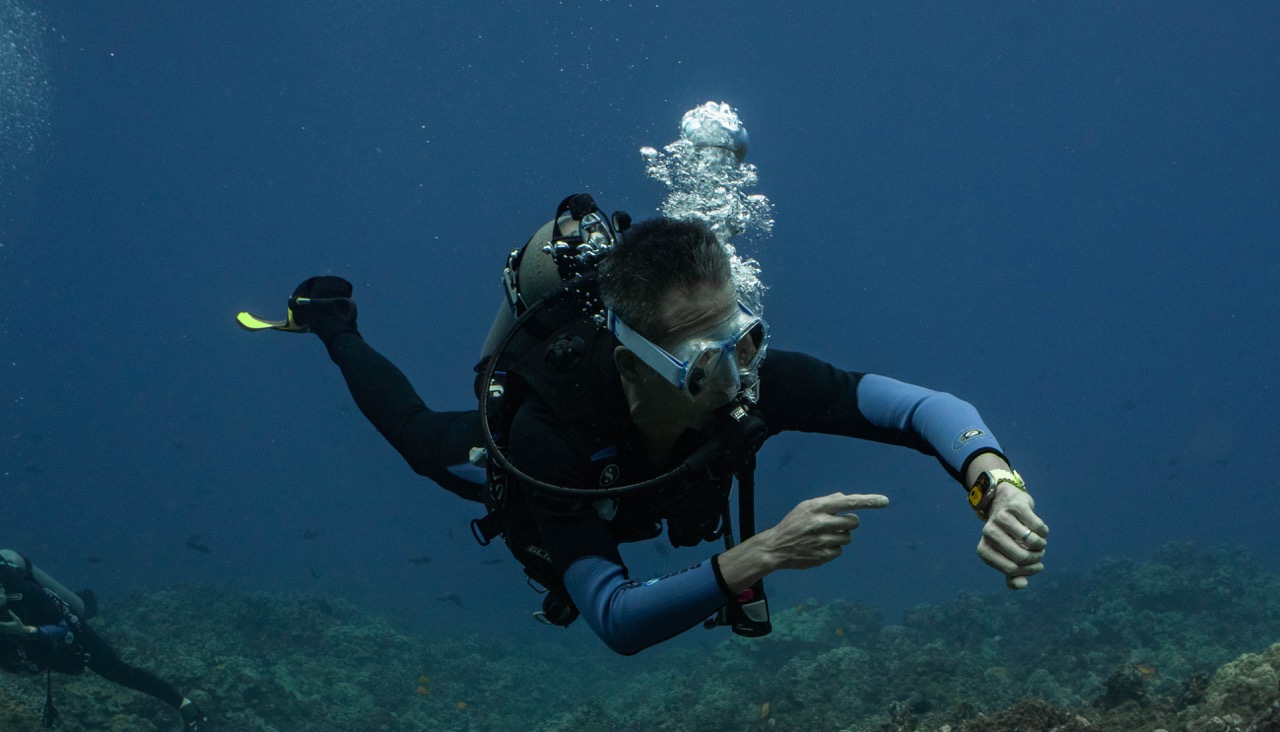Category: TECHNOLOGY
V7 snaps up $33M to automate training data for computer vision AI models
Artificial intelligence promises to help, and maybe even replace, humans to carry out everyday tasks and solve problems that humans have been unable to tackle, yet ironically, building that AI faces a major scaling problem. It’s only as good as the models and data used to train it, so there is a need for sourcing and ingesting ever-larger data troves. But annotating and manipulating that training data takes a lot of time and money, slowing down the work or overall effectiveness, and maybe both.
A startup called V7 Labs believes it’s had a breakthrough in how this is approached. It’s effectively built training models to automate the training of those models. Today it’s announcing $33 million in funding to fuel its growth after seeing a lot of demand for its services.
V7’s focus today is on computer vision and helping identify objects. It says it can learn what to do from just 100 human-annotated examples.
It currently has strong traction in the fields of medicine and science, where its platform is being used to help train AI models to speed up, for example, how cancers and other issues are identified on scans. V7 is also starting to see activity with tech and tech-savvy companies looking at how to apply its tech in a wide variety of other applications, including companies building engines to create images out of natural language commands and industrial applications. It’s not disclosing a full list of customers and those evaluating its tech but the list numbers over 300 clients and includes GE Healthcare, Paige AI, and Siemens, alongside other Fortune 500 companies and larger privately-held businesses.
Radical Ventures and Temasek are co-leading this round, with Air Street Capital, Amadeus Capital Partners, and Partech (three previous backers) also participating, along with a number of individuals prominent in the world of machine learning and AI. They include Francois Chollet (the creator of Keras, the open-source Python neural network library), Oriol Vinyals (a principal research scientist at DeepMind), Jose Valim (creator of the Elixir programming language), Ashish Vaswani (a co-founder of Adept AI who had previously been at Google Brain, where he invented Transformers) and unnamed others from OpenAI, Twitter, and Amazon.
CEO Alberto Rizzoli said in an interview that this is the largest Series A funding round in this category to date, and it will be used both to hire more engineers as well as to build out its business operations to take on a new wave of customer interest with an emphasis on the U.S. He declined to comment on valuation, but the startup has now raised around $36 million, and from what I understand the valuation is now around $200 million.
Rizzoli also declined to talk about revenue figures but said that ARR grew three-fold in 2022
There have been a number of other startups that have emerged to help improve the efficiency of training AI data and to address the wider area of AI modeling. SuperAnnotate, which has raised about $18 million per PitchBook, is one of V7’s closer competitors. (V7 even lays out how the two services compare.) Others include Scale AI, which initially focused on the automotive sector but has since branched into a number of other areas and is now valued at around $7 billion; Labelbox, which works with companies like Google and others on AI labelling; and Hive, which is now valued at around $2 billion.
V7 — named in reference to AI being the “seventh” area for processing images after the six areas in the human brain that form its visual cortex (V1 through V6) — and the others are banking on the fact that the training model is inefficient and can be improved.
V7’s specific USP is automation. It estimates that around 80% of an engineering team’s time is spent on managing that training data: labelling, identifying when something is incorrectly labelled, rethinking categorizations and so on, and so it has built a model to automate that process.
It calls the process it’s come up with “programmatic labelling”: using general-purpose AI and its own algorithms to segment and label images, Rizzoli (who co-founded the company with its CTO Simon Edwardsson) says that it takes just 100 “human-guided” examples for its automated labelling to kick into action.
Investors are betting that shortening the time between AI models being devised and applied will drive more business for the company. “Computer vision is being deployed at scale across industries, delivering innovation and breakthroughs, and a fast growing $50 billion market. Our thesis for V7 is that the breadth of applications, and the speed at which new products are expected to be launched in the market, call for a centralised platform that connects AI models, code, and humans in a looped ecosystem,” said Pierre Socha, a partner at Amadeus Capital Partners, in a statement.
V7 describes the process as “autopilot” but co-pilot might be more accurate: the idea is that anything flagged as unclear is routed back to humans to evaluate and review. It doesn’t so much replace those humans as makes it easier for them to get through workloads more efficiently. (It can also work better than the humans at times, so the two used in tandem could be helpful to double check each other’s work.) Below is an example of how the image training is working on a scan to detect pneumonia.
Image Credits: v7 labs
Considering the many areas where AI is being applied to improve how images are processed and used, Rizzoli said the decision to double down on the field of medicine initially was partly to keep the startup’s feet on the ground, and to focus on a market that might not have never built this kind of technology in-house, but would definitely want to use it.
“We decided to focus on verticals that are already commercializing AI-based applications, or where a lot of work on visual processing is being done, but by humans,” he said. “We didn’t want to be tied to moonshots or projects that are being run out of big R&D budgets because that means someone is looking to fully solve the problem themselves, and they are doing something more specialized, and they may want to have their own technology, not that of a third party like us.”
And in addition to companies’ search for “their own secret sauce”, sometimes projects might never see the light of day outside of the lab, Rizzoli added. “We are instead working for actual applications,” he said.
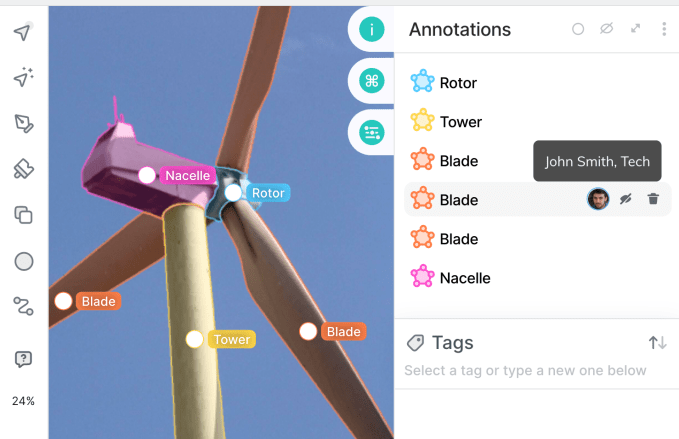
Image Credits: V7 Labs (opens in a new window)
In another regard, the startup represents a shift we’re seeing in how information is being sourced and adopted among enterprises. Investors think that the framework that V7 is building might potentially change how data is ingested by those enterprises in the future.
“V7 is well-positioned to become the industry-standard for managing data in modern AI workflows,” said Parasvil Patel, a partner with Radical Ventures, in a statement. Patel is joining V7’s board with this round.
“The number of problems that are now solvable with AI is vast and growing quickly. As businesses of all sizes race to capture these opportunities, they need best-in-class data and model infrastructure to deliver outstanding products that continuously improve and adapt to real-world needs,” added Nathan Benaich of Air Street Capital, in a statement. “This is where V7’s AI Data Engine shines. No matter the sector or application, customers rely on V7 to ship robust AI-first products faster than ever before. V7 packages the industry’s rapidly evolving best practices into multiplayer workflows from data to model to product”.
V7 snaps up $33M to automate training data for computer vision AI models by Ingrid Lunden originally published on TechCrunch
https://techcrunch.com/2022/11/28/v7-labs-computer-vision-ai/
Bahamian Attorney General Defends Handling of FTX Collapse
Island nation’s leaders are under pressure after encouraging cryptocurrency companies to do business there in recent years.
3 mistakes to avoid as an emerging manager
Contributor
By all accounts, I was a successful emerging manager. I raised $65 million with fewer than 25 LPs, including an institutional fund of funds and a sovereign wealth fund. I was not a spin-out manager from a name brand fund. Hell, I didn’t even have a VC or tech background.
Still, I spent a good chunk of my fundraising period wrestling an unrelenting sense of self-criticism I couldn’t ignore. Fortunately, listening to that critical inner voice instead of ignoring it led to my success.
While there’s no one right way to go about fundraising, there are a few wrong ways — and failure is a wonderful teacher. Here’s how I learned from my failures in order to succeed as an emerging manager:
LPs don’t care about the same things you do
As a systematic fund that spent thousands of hours unearthing unique insights through deep research, I assumed that my LPs would care to know exactly what that research process looked like, what insights were uncovered and how they applied to our investments.
Instead of holding a rolling close, let the momentum build up and use that to create FOMO to force a formal closing.
To my surprise, they really didn’t care about any of that. At least not to the extent I thought they would.
By over-explaining how I was going to make them money, I committed the same mistake I’ve seen many technical founders make: talking incessantly about perceived superiority without gauging my listener’s actual interest in the topic.
3 mistakes to avoid as an emerging manager by Ram Iyer originally published on TechCrunch
https://techcrunch.com/2022/11/28/3-mistakes-to-avoid-as-an-emerging-manager/
Yahoo gets 25% stake in Taboola as part of long-term advertising deal
Yahoo is taking a nearly 25% stake in advertising network Taboola. In exchange for this move, Taboola is becoming Yahoo’s native advertising partner through a 30-year commercial agreement.
If you’re not familiar with Taboola, you may have seen its content recommendation widgets on popular news websites, such as USA Today, Insider and The Weather Channel. They mostly feature sponsored links that lead to third-party websites. Those links appear in recommendation widgets at the end of news articles or in the middle of a content newsfeed.
Yahoo is a name that you may already know quite well. It is now a private company owned by investment firm Apollo Global Management. It owns many popular media properties, such as Yahoo Finance, Yahoo Sports, Yahoo News, AOL and Engadget. Yahoo’s homepage and Yahoo Mail are also important products for the company as they attract large audiences. Yahoo is TechCrunch’s parent company as well.
This isn’t the first time Taboola is signing a strategic partnership that covers some of these properties. In 2015, Verizon acquired AOL. The next year, Taboola and AOL signed a strategic partnership that led to integrations of Taboola’s ads on AOL properties. Shortly after, Verizon also acquired Yahoo and merged AOL with Yahoo.
And now, the second incarnation of Yahoo, which includes AOL’s activities and operates separately from Verizon, is doubling down on digital advertising. With this new deal, Taboola becomes the exclusive partner for native advertising across all of Yahoo’s digital properties.
It means that you’ll soon scroll through news articles on Yahoo Finance and see an item that looks just like a normal article. But it will be a Taboola-powered advertising unit instead. Or at least, that’s the idea. Advertisers will be able to buy Taboola through the Yahoo DSP.
“Partnering with Taboola enables Yahoo to further enhance the contextual and native offerings within our unified advertising stack. The partnership also allows Yahoo and Taboola to continue to differentiate in market, improving user, advertiser and publisher experiences across properties, while benefiting from the long-term tailwinds in digital native advertising,” Yahoo CEO Jim Lanzone said in a statement.
As Yahoo currently reaches nearly 900 million monthly active users, it represents a significant deal for Taboola. Right now, Taboola partners with 9,000 publishers and reaches 500 million users every day.
This deal isn’t just a way to display Taboola ads in front of more eyeballs. As technology companies and regulators are cracking down on privacy-invasive targeting methods, adtech companies like Taboola need to find new ways to target audiences in an effective way.
“Our collaboration with Yahoo will give advertisers access to what I believe is the most sophisticated contextual dataset online. Together, we’re going to build a ‘Contextual Powerhouse’, enabling advertisers to target relevant audiences without relying on third-party cookies and while maintaining complete user privacy,” Taboola founder and CEO Adam Singolda writes in a blog post.
Taboola went public last year by merging with a special purpose acquisition company, also known as a SPAC. Taboola shares (NASDAQ:TBLA) are currently up 70% in pre-market trading compared to yesterday’s closing price — but Taboola shares have been steadily going down over the past twelve months. Shares should open at around $3.14.
As part of the deal, Yahoo is becoming Taboola’s largest shareholder with a 24.99% stake in the advertising network company. Yahoo will also get a seat on Taboola’s board of directors. Both companies expect to generate $1 billion in annual revenue from this newly formed partnership if integrations go well.
Yahoo gets 25% stake in Taboola as part of long-term advertising deal by Romain Dillet originally published on TechCrunch
SWVL reduces its headcount by 50% six months after axing 400+ staff
Cairo-born and Dubai-based mass transit and shared mobility services provider SWVL has carried out its second round of layoffs affecting 50% of its remaining headcount, according to a statement shared by the company.
The news is coming six months after SWVL laid off 32% of its workforce in a “portfolio optimization program” effort geared towards achieving positive cash flow next year. Over 400 employees were affected at the time, leaving more than 900 behind at the mobility company, based on data from its LinkedIn profile. But with the second round of layoffs, the number of employees at SWVL would have reduced to a little over 450.
Reports about a second round of layoffs at SWVL had been circulating for over two weeks as axed employees took to LinkedIn to share that they were open to new job opportunities. Local media said the layoffs affected teams across multiple departments including tech and HR in Dubai and Pakistan. Another report has it that SWVL completely shuttered its Pakistan operations entirely two weeks ago
Although SWVL, in its statement, didn’t confirm these reports, it did not that it was evaluating a “potential sale, scale back or discontinuation of operations” of its smaller markets. It’s unclear what markets the Dubai-based mobility company is referring to but several sources have referred to Pakistan as one of its larger markets. As of June, SWVL, in its financial statement to investors, said it was present in 20 markets across 4 continents: the UAE, Egypt, Kenya, Germany, Spain, Italy, Switzerland, Turkey, Japan, Argentina, Saudi Arabia, Mexico, Jordan, Kuwait, Pakistan, Chile, France, the U.K., Portugal and Brazil.
SWVL went into some of these markets via acquisitions: Germany’s door2door, Turkey’s Voltlines, Mexico’s Urbvan, Spain’s Shotl and Argentina’s Viapool (its planned acquisition of U.K.-based Zeelo was called off in July). When SWVL conducted its first round of layoffs, it said that though the acquisitions contributed to its overall growth, it needed to make reductions on roles automated by investments in its engineering, product and support functions teams. However, the second round of layoffs reveals a different story: the current economic downturn has exposed that SWVL scaled too fast and didn’t have the necessary systems in place to make the acquisitions work.
SWVL’s sloppy operations – despite claiming that it turned EBITDA positive or break even in half of its markets as of August – are also evident in its stock market performance so far. In March, the mobility company went public via a SPAC merger with U.S. women-led blank check company Queen’s Gambit Growth Capital. It listed at $9.95 per share on Nasdaq and targeted a $1.5 billion valuation. Several months later, SWVL has seen its valuation tank to $53 million and its share price drop by over 90% to $0.40 (price before the market opening). As a result, SWVL received a letter from Nasdaq this month saying it was not in compliance with a listing rule (its shares traded below $1 for 30 consecutive business days) and it had until May 1, 2023 (180 days) to regain compliance and avoid delisting (get its shares above $1).
Cutting costs is one way SWVL believes will, in some way, affect its share price. The Dubai-based company stated it is taking these measures amid the continuing uncertainty in the global economic environment as the volatility in capital markets “potentially impact SWVL’s ability to generate sufficient cash from operating activities and external financings to fund working capital and service its commitments.” The company, in the statement, said it is also reducing operating expenses including discretionary spending such as marketing expenses and other third-party services. Going forward, SWVL’s broader optimization plan is to sharpen its focus on its largest markets which contribute the most to its revenues including Egypt and Mexico.
For the first half of the year, SWVL made $40.7 million in revenue, a 3.2x growth from H1 2021; however, its losses (including operating loss and recapitalization costs) during this same time amounted to over $161.6 million.
SWVL reduces its headcount by 50% six months after axing 400+ staff by Tage Kene-Okafor originally published on TechCrunch
https://techcrunch.com/2022/11/28/swvl-reduces-its-headcount-by-50-six-months-after-axing-400-staff/
BackingMinds raises new €50 million fund to fund normally overlooked entrepreneurs
Denmark-based venture fund BackingMinds, founded in 2016, likes to think it takes a different approach to venture in Europe. Its new €50 million fund will aim to take a road less travelled by most VCs, looking “for the blind spots” traditional venture capital can often miss because of typical VC herd behaviour (such as investing in white men in major capital cities).
Instead, the new fund will look for companies with high potential outside of Europe’s capital cities and entrepreneurs often overlooked by traditional investors.
The investment range of the fund will be €500,000 to €3,000,000 on initial investments, and across the whole of entire Europe, except the UK, due to it being outside the EU.
“Sweden is far ahead in terms of demographic and digital transformation and we can apply many insights when looking for overlooked opportunities in Denmark and the Nordics,” said Susanne Najafi, founder of BackingMinds, in a statement.
The fund’s geographical focus is northern Europe, and includes LPs from Spotify, King, Supercell, and the H&M family office, but so far no institutional investors.
Those LPs include Supercell’s chief executive Ilkka Paananen, the Persson family that owns retailer H&M, and co-founder of Spotify, Martin Lorentzon. Other investors in the new fund include the founders of private equity firms EQT and Nordic Capital, Thomas Hartwig, who is co-founder of King — the company behind Candy Crush Saga. Also the founders of software company Sinch Robert Gerstmann and Kristian Mannik, and the Olsson family behind the Stena group of companies, including the ferry operator.
After launching in 2016 with an undisclosed fund size, BackingMinds says it has since invested in 13 companies which are either led by women, immigrants, or lie outside the Stockholm region.
“It’s not about charity or diversity investing, it’s about driving societal change and even out injustices by making good returns. We go straight to the solution, challenging bias and put focus on blind spots by delivering returns in companies where traditional investors see nothing but risks,” added Sara Wimmercranz.
Najafi, was previously the founder of more than ten companies, several of which she exited, including Eleven, one of the largest beauty e-tailers in the Nordics. Wimmercranz previously co-founded the e-commerce company Footway, listed at First North Stockholm with a market cap of SEK 2 bn. They are joined by partners Sara Resvik and Niklas Thörnestad.
BackingMinds claims that evidence of these homogeneous networks and herd behaviour is showing up in the VC data which shows most Danish VCs only investing in Danish startups, not further afield, while immigrant founders are often ignored.
Investments to date:
● Brain Stimulation: Precision diagnostics and individualised digital rehabilitation.
● Cemvision: Re-inventing cement with a product that is economical, environmental friendly and technically superior.
● Combify: Construction tech specialised in digitalisation and visualisation of data related to construction projects.
● Lingio: Industry-validated language learning to improve operational efficiency in the labour market.
● Serviceform: Makes complex technologies simple and bring them all under one service – for all businesses.
● Skrym: A headless solution for optimising logistics with built-in emissions tracking.
BackingMinds raises new €50 million fund to fund normally overlooked entrepreneurs by Mike Butcher originally published on TechCrunch
Meta hit with ~$275M GDPR penalty for Facebook data-scraping breach
Facebook’s parent, Meta, has been hit with another hefty penalty for breaching European data protection law.
The €265 million (~$275M) fine was announced today by the Irish Data Protection Commission (DPC), the tech giant’s lead regulator for the European Union’s General Data Protection Regulation (GDPR).
The DPC confirmed that the decision, which was adopted on Friday, records findings of infringement of Articles 25(1) and 25(2) GDPR — which are focused on data protection by design and default.
The DPC said it is also imposing a range of corrective measures, writing: “The decision imposed a reprimand and an order requiring MPIL [Meta Platforms Ireland Limited] to bring its processing into compliance by taking a range of specified remedial actions within a particular timeframe.”
The penalty relates to an inquiry which was opened by the DPC on April 14, 2021, following media reports of more than 530M Facebook users’ personal data — including email addresses and mobile phone numbers — being exposed online.
At the time, Facebook tried to play down the breach — claiming the data that had been found floating around online was “old data” and that it had fixed the issue that led to the personal data being exposed.
The company followed that by saying it believed the data had been scraped from Facebook profiles by “malicious actors” using a contact importer feature it offered up to September 2019, before it tweaked it to prevent data abuse by blocking the ability to upload a large set of phone numbers to find ones that matched Facebook profiles.
The DPC confirmed its inquiry looked at a variety of contact search and importer tools the company offers on its platforms between the date the GDPR came into application and the date of changes to the contact importer tool Facebook made in fall 2019.
“The scope of the inquiry concerned an examination and assessment of Facebook Search, Facebook Messenger Contact Importer and Instagram Contact Importer tools in relation to processing carried out by Meta Platforms Ireland Limited (‘MPIL’) during the period between 25 May 2018 and September 2019,” the DPC wrote.
“The material issues in this inquiry concerned questions of compliance with the GDPR obligation for Data Protection by Design and Default,” it added, specifying that it had examined the implementation of “technical and organisational” measures relevant to Article 25 GDPR (which deals with data protection by design and default).
“There was a comprehensive inquiry process, including cooperation with all of the other data protection supervisory authorities within the EU. Those supervisory authorities agreed with the decision of the DPC,” the regulator also said — putting a spotlight on the lack of disagreement over this particular decision, which is often not the case with cross-border GDPR enforcements (while disputes between EU regulators can often substantially increase the time it takes to enforce the GDPR — hence this final decision has landed relatively quickly).
DPC deputy commissioner, Graham Doyle, told TechCrunch that the corrective measures it has applied to Meta as part of this decision are “an order pursuant to Article 58(2)(d) GDPR… to bring its processing into compliance with the GDPR in the manner specified in this Decision” — with the company getting a deadline of three months from the date of the final decision to comply with that.
“Specifically, to the extent that MPIL is engaged in ongoing processing of personal data which includes a default searchability setting of ‘Everyone’, this order requires… MPIL to implement appropriate technical and organisational measures regarding the Relevant Features in respect of any ongoing processing of personal data, for ensuring that, by default, only personal data which are necessary for each specific purpose of the processing are processed, and that by default personal data are not made accessible without the individual’s intervention to an indefinite number of natural persons,” he added, emphasizing: “This order is made to ensure compliance with Article 25(2) GDPR.”
“Relevant Features” in this context are Facebook Contact Importer; Messenger Contact Importer; Instagram Contact Importer; and Messenger Search; and its variant Messenger Contact Creator features.
Meta was contacted for a response. A spokesman did not confirm whether or not it will seek to appeal — but the tech giant said it is “reviewing” the decision “carefully”.
Here’s Meta’s statement:
“Protecting the privacy and security of people’s data is fundamental to how our business works. That’s why we have cooperated fully with the Irish Data Protection Commission on this important issue. We made changes to our systems during the time in question, including removing the ability to scrape our features in this way using phone numbers. Unauthorised data scraping is unacceptable and against our rules and we will continue working with our peers on this industry challenge. We are reviewing this decision carefully.”
The company added that it has put in place a range of measures to combat data scraping since this breach — including applying rate limits and deploying technical tools to combat suspicious automated activity, as well as providing users with controls to limit the public visibility of their information.
The GDPR penalty is not the first for Meta — and it may not be its last.
Just over a year ago, Meta-owned WhatsApp was fined €225M (~$267M) for transparency breaches. While, back in March, the company was also fined around $18.6M over a string of historical Facebook data breaches.
The DPC also has a number of ongoing enquiries into other aspects of Meta’s business — not least a major probe of the legal basis Meta claims to be able to process people’s data which dates back around 4.5 years.
Meta hit with ~$275M GDPR penalty for Facebook data-scraping breach by Natasha Lomas originally published on TechCrunch
Apple and Huish devise clever pricing model for divers with Oceanic+ app
The Oceanic+ app has a number of features available for free:
- Snorkeling
- Gauges
- Depth meter
- Max depth tracking
- Last dive time
- Maximum elapsed time
- Total activity time
- GPS location for an actiity
- Logbook
- Cumulative lifetime dive time
- Total number of dives
- Deepest dive
- Longest dive
- Dive ratings (you can rate your dive and specifics about the dive)
- Sharing activities to social networks
- Storing pictures
To get its advanced features, however, you have to pony up for a subscription. This is where things get clever. Renting a dive computer from a dive shop can cost anywhere from $5-$30 per day, and very few divers would choose to go without these days.
This is where the Oceanic+ makers did something clever. Instead of only having very long-term subscription plans (such as $80 per year, for example), the app makers devised shorter plans that suit divers extremely well:
- $4.99 per day
- $9.99 per month
- $79.99 per year
- $129 per year for “family share” up to five people.

You subscribe to the app for a day, month, or year via the Oceanic+ iPhone app. Image Credit: Huish Outdoors
Assuming you already have an Apple Watch Ultra, the above becomes a no-brainer. For the same price as the cheapest dive computer rental I could find, you can use your existing Apple Watch as a dive computer. Most dive trips last less than a month, so for $10, you’re covered for as much diving as you can stomach. And if you’re planning more than one dive trip in a year, you can shell out a bit extra.
The cool thing about the features that are added when you subscribe is that they are only strictly needed when you are actively diving. If you just want to refer back to your past dives once you’re safely back at home, that’s made possible by the free app.
The paid app adds the following features:
- Tissue loading – the bit you need to avoid decompression sickness
- Decompression info – that’s the part you need to stay safe as you are in the water, and calculates the surface intervals, and the time it takes before you can safely fly in an airplane after you’ve been diving
- Community dive conditions – water temperature, visibility, and currents, etc.
- Local 3-day weather forecast for your dive sites
- Local 3-day temperature forecast for your dive sites
- UV index
Of course, not everybody will be falling over themselves to spend $800 on the Apple Watch Ultra, but for those who did for the diving feature, the days of having to use a rented dive computer may be counted. If you can afford to buy the watch, the pricing plans mean that you’d be crazy to spend more than you have to in order to go meet some fish.
Oceanic+, developed by Huish Outdoors, made a splash at this year’s Apple Fall Event in September, when Apple pulled a surprise new watch out of its proverbial hat, the Apple Watch Ultra. One of the surprises was that the $800 watch is rated for recreational scuba diving, enabling owners to take it underwater to 40 meters or 130-ish feet.
Pre-installed on the watch is a Depth app, which shows depth, water temperature and a few other things. As a scuba diver, however, you need more than that. To avoid decompression sickness (the bends), you need a dive computer that logs how long you stay at certain depths. The precise instruments measuring and logging depth and time, paired with an algorithm, makes up a dive computer. This is pretty specialized stuff, and it makes sense that Apple decided to partner with an external supplier — in this case the scuba veterans at Huish Outdoors.
I reviewed the app and watch combo, but I wanted to talk about the pricing model and how it, in itself, is a game changer for scuba divers.
You can rent a dive computer from most dive shops, of course, but this comes with some (very slight) risk: If the computer was used by another diver the day before, their dive profile might influence yours. The worst that can happen is that the computer believes that you have less no decompression time than you really do. In other words: You may have to do shorter, shallower dives.
Because of this, and a few other reasons, serious divers usually have their own dive computers. The issue is that these often lay around for long stretches of time. Turning up to go diving, only to discover that the battery in my dive computer is low, is frighteningly common both for many of my fellow divers and for myself. When that happens, you end up scrambling to get a replacement battery (not trivial, as the dive computer needs to be re-sealed properly afterwards, and not everyone has the right tools to do that), or rent a dive computer and bring that with you as a backup.
A Scuba diver observes that the target 30 minute dive time alarm has been reached. Image Credit: Bang Bang Studios
The Oceanic+ app has a number of features available for free:
- Snorkeling
- Gauges
- Depth meter
- Max depth tracking
- Last dive time
- Maximum elapsed time
- Total activity time
- GPS location for an actiity
- Logbook
- Cumulative lifetime dive time
- Total number of dives
- Deepest dive
- Longest dive
- Dive ratings (you can rate your dive and specifics about the dive)
- Sharing activities to social networks
- Storing pictures
To get its advanced features, however, you have to pony up for a subscription. This is where things get clever. Renting a dive computer from a dive shop can cost anywhere from $5-$30 per day, and very few divers would choose to go without these days.
This is where the Oceanic+ makers did something clever. Instead of only having very long-term subscription plans (such as $80 per year, for example), the app makers devised shorter plans that suit divers extremely well:
- $4.99 per day
- $9.99 per month
- $79.99 per year
- $129 per year for “family share” up to five people.

You subscribe to the app for a day, month, or year via the Oceanic+ iPhone app. Image Credit: Huish Outdoors
Assuming you already have an Apple Watch Ultra, the above becomes a no-brainer. For the same price as the cheapest dive computer rental I could find, you can use your existing Apple Watch as a dive computer. Most dive trips last less than a month, so for $10, you’re covered for as much diving as you can stomach. And if you’re planning more than one dive trip in a year, you can shell out a bit extra.
The cool thing about the features that are added when you subscribe is that they are only strictly needed when you are actively diving. If you just want to refer back to your past dives once you’re safely back at home, that’s made possible by the free app.
The paid app adds the following features:
- Tissue loading – the bit you need to avoid decompression sickness
- Decompression info – that’s the part you need to stay safe as you are in the water, and calculates the surface intervals, and the time it takes before you can safely fly in an airplane after you’ve been diving
- Community dive conditions – water temperature, visibility, and currents, etc.
- Local 3-day weather forecast for your dive sites
- Local 3-day temperature forecast for your dive sites
- UV index
Of course, not everybody will be falling over themselves to spend $800 on the Apple Watch Ultra, but for those who did for the diving feature, the days of having to use a rented dive computer may be counted. If you can afford to buy the watch, the pricing plans mean that you’d be crazy to spend more than you have to in order to go meet some fish.
Apple and Huish devise clever pricing model for divers with Oceanic+ app by Haje Jan Kamps originally published on TechCrunch
https://techcrunch.com/2022/11/28/oceanic-plus-pricing-model/
Lessons for raising $10M without giving up a board seat
Contributor
As a startup founder, you have no shortage of voices to listen to. Most of those voices — especially those from venture capital or other startups — tend to give you a singular piece of advice when it comes to fundraising: Basically, raise as much as you can as fast as you can. This isn’t “bad” advice, per se, but given the funding environment we find ourselves in, it may not be the most realistic.
My co-founder and I started Reclaim.ai nearly four years ago, and our path to raising capital has been far from conventional. We realized early on that we tended to build best (and pitch best) using a more incremental approach — raising modest sums of capital as we grew rather than using a pitch deck and raising multiple rounds. Doing this not only gave us a more sustainable business that had less risk of entering zombie unicorn territory, it also let us build faster, and we had fewer distractions and more control.
I’ve written about this before, and we’ve since continued to follow that mantra as Reclaim has evolved. We recently raised another $3.2 million to power our next phase of growth, bringing our total funding to nearly $10 million over the past two years. We’ve done all this without giving up a single board seat, and Reclaim employees continue to own over two-thirds of the company’s equity.
Raise capital by all means, but be conscious of the fact that raising too much means you may be relinquishing control at a very early and sensitive stage.
Here are three lessons we’ve learned from this journey:
Belief goes farther than a pitch deck
Our most recent round of funding came from a mix of new and existing investors. In fact, the round was fueled by a couple of key insiders who believed in what we were doing so much that they went to bat for us and brought in other angels and firms to the table. We didn’t have to do much pitching and outreach in the end.
To do this, we first identified the people in our cap table who seemed most likely to be interested in expanding ownership based on their profile and relationship. Second, we used an instrument called a SAFE to help expedite the process and reduce due diligence pain. Lastly, we emphasized lightweight growth metrics instead of a full deck to keep the focus on a few key points.
Lessons for raising $10M without giving up a board seat by Ram Iyer originally published on TechCrunch
https://techcrunch.com/2022/11/28/lessons-for-raising-10m-without-giving-up-a-board-seat/
We went diving with the Apple Watch Ultra
At the surface, the watch can be used for dive planning and a log book, and to configure the settings for your next dive. If you have a recent dive on the books, it can also show you your surface interval time.
None of this is rocket science; dive computers have been able to do most of these things as long as they have been around. The Apple Watch Ultra’s huge touch-screen makes the user experience significantly nicer than on traditional dive watches, which can be pretty indescipherable from time to time. Think user interfaces that seem like relics from the 1980s Casio watch era, and you get a pretty good idea.

Dive Planner, Dive Mode and the logbook are all easily accessible when you’re at the surface. Image Credit: Apple.
Dive planning helps you use your current tissue loading to figure out how deep and how long you can dive for after a surface interval.
The log book helps you see the depth profile of your recent dives, along with dive time, max ascent rate, water temperature, maximum depth and the gas mix (air at 21% oxygen or
In September, Apple launched the Apple Watch Ultra, which is not only waterproof to 100 meters (330 feet) in depth, but can also be used as a dive computer with the help of a companion app developed by Huish Outdoors. We took it into the deep blue sea to test it out.
I’ve been an enthusiastic scuba diver for more than a decade. I’ve logged hundreds of dives, and I’ve earned a handful of qualifications over the years: I’m an SSI Rescue Diver, an SSI Master Diver and a PADI Divemaster; I’ve also completed a bunch of specialty training over the years. If that means nothing to you, suffice it to say I’m trained in dive-specific first aid, and if you are diving with me, I can (at least in theory) save your life if something goes wrong. I’m also qualified to lead dive tours.
I’m also a big hardware and gadgets nerd, so when Apple first announced that the Apple Watch Ultra could be used as a dive computer, I got very excited and brazenly wrote that I would gladly trust my life to the freshest and chunkiest wrist-worn supercomputer from the Cupertino-based electronics manufacturer. The article got me some, er, interesting feedback from the dive community, but I stand by it. So when Apple gave me early access to the Huish Outdoors Oceanic+ app and an Apple Watch Ultra, I decided to put my money where my regulator goes, book a flight to Hawaii, and see if it could stand the pressure of 100 feet of seawater under my watchful eyes.
Was I nervous? Not really. A dive computer can fail without putting divers’ lives at risk. That said, I should mention that while the Apple Watch Ultra is in its full and final form, the Oceanic+ app was not. I was running a beta version, which did introduce a couple of nerves. The watch app was full-featured and worked sleekly, but the iPhone compendium app was a little rough at the edges, still.
The Oceanic+ watch app itself is where the brunt of the heavy lifting is done, so I’ll spend most of my focus there, but let’s start with a slight detour into some theory…
What’s a dive computer?
If you’re a veteran scuba diver, you probably don’t need this refresher, but for this review to truly make sense, we need to get a little bit nerdy about what a dive computer is and why it’s important to use one.
You may have heard of “the bends,” or decompression sickness. This is a potentially medically serious condition that can occur when you breathe a gas (usually air) at pressure (such as underwater). The problem is that when a gas is at pressure, it goes in through your lungs, and the nitrogen in the gas gets absorbed into your bloodstream. From there, it goes everywhere your blood goes – your muscles, your fat, your brain, your guts, and all your other tissues. This isn’t dangerous in itself, as long as the gas stays “in solution” – in other words, as long as your blood stays liquid, your fat stays fat, and your brain stays sans air bubbles.
If you reduce the pressure too quickly, for example, by surfacing from a dive too quickly, physics flexes its mighty arms (in the form of Boyle’s Law), and that gas can come out of solution, forming little bubbles. Those little bubbles can collect in places you don’t want them and cause very serious issues. A small air bubble in a blood vessel in your brain can cause an embolism. The same air bubble in your heart can cause heart attacks and air anywhere there shouldn’t be air can cause a number of other nasty effects. “Minor” issues are also possible, which can lead to rashes, itches or other unpleasantness. If you want a deep dive into all the nasty stuff that can happen, feel free to Google decompression sickness and dive injuries, and you’ll come across some gnarly shit.
The quirk that complicates all of this is that different tissues take on and release nitrogen at different rates, so you need to keep a close eye on things.
A scuba diver observes that the target 30-minute dive time alarm has been reached. Image credit: Bang Bang Media.
For recreational scuba divers, there is a pretty straightforward way of avoiding decompression sickness:
- When diving, divers tend to the deepest part of their dive first, and then gradually and slowly go shallower and shallower on their dive, ensuring they don’t ascend faster than a certain ascent rate. A dive computer helps here: It will warn you if you are ascending too fast.
- When diving, ensure that they don’t stay down too deep for too long so slow-loading tissues don’t get overloaded with nitrogen. Slow-loading tissues also offload more slowly, and they can cause problems even if you stick to all the other rules of diving. A dive computer will help here, too, by using algorithms to keep a model of how much each of a diver’s tissues are loaded with nitrogen and advise divers to go shallower or to end a dive if they are overloaded. (The algorithm Oceanic+ uses keeps track of 16 different theoretical tissue types, weighted in different ways to keep recreational divers as safe as possible.)
- Finally, divers can give themselves some surface time between dives to properly give their body time to off-gas. In addition to diving, it’s important not to go mountaineering or get on a plane too soon after diving, and don’t dive too deep or too often in rapid succession. How do you keep track of all of that? You guessed it: A dive computer.
In the early days of scuba diving, before dive computers were a thing, you’d use a depth gauge and a watch. Your depth gauge would measure how deep you went, and your watch would be used to keep track of how long you stayed down there. And to calculate how much time you could spend underwater, you’d use dive tables. These early dive tables were calculated by essentially testing on daredevil navy divers in the early 1900s.
As you might expect, they had some issues: Most of the people in the tests were male, 18-25 years of age, and in very good shape. I can just about pass for male, but the rest of those things are not true for me. The other problem is that the dive tables don’t really have a concept of multi-level dives: They assume that you plunge to a certain depth (in the case of a navy diver, plant explosives on an enemy ship), stay there to do a job and then resurface. That’s not really how people dive for fun anymore.
So as soon as dive computers became reasonably accessible, people started using those instead. The first dive computers became available in the 1980s, and they started being reasonably priced – putting them in range of recreational divers in the late 1990s. They could beep at you when you ascended too fast, keep track of your tissue loading, and keep track of multi-depth, multi-dive scenarios that quickly become too complicated to figure out by hand. Some dive training still includes the use of dive tables to support teaching the theory and history, but the vast majority of divers don’t use those after they pass their certification.
The Oceanic+ app uses the Bühlmann decompression algorithm, which is widely used and trusted across the dive industry.
So do you need a dive computer to keep you safe?
As part of your dive training, you are taught how to surface safely from a dive. While a dive computer telling you how fast you are ascending can be a good safety blanket, if your computer should fail and all your other instruments also crap the bed, you can still safely make it back to the boat.
A trick most divers are taught is to “ascend at the rate of your smallest bubbles.” In other words, they breathe out through their regulator, and waft their hand through the bubbles that form. Find the smallest bubble; it will be ascending very slowly through the water. Keep pace with it all the way to the surface, and you will be ascending at a safe, slow rate.
Now, if your dive computer did fail, a safe, conservative diver wouldn’t choose to dive again that day. In theory you could buddy up with a diver who had a more aggressive dive profile than you in previous dives (i.e. they went deeper for longer than you) and you could assume that their dive computer’s data would be safe for you, too. If you stay shallower than them on the next dive, you should, in theory, be fine. However, if you dive on different gases (say, your Nitrox mix was 32% and theirs was 30% oxygen), or if they have done fewer dives than you recently, things get tricky.
In addition, a dive computer is a personal safety device. If you did end up with decompression sickness, the dive medics at the hyperbaric chamber will use the data from your dive computer to figure out what happened and how to treat you. In theory, because no sensible divemaster will recommend you use someone else’s dive computer as a proxy for your safety, most dive operations will ask you not to, and no dive certification body will condone this sort of thing. I would explain all of that to you, and then I’d add — hey, as a certified diver, you’re responsible for your own safety; you do what fits with your acceptable risk profile.
All of this is to say that it isn’t actually dangerous or scary to trust my diving experience to a brand-new Apple Watch and the beta version of an app. I did dive with a second dive computer in the pocket of my Buoyancy Compensator Device (BCD – that’s the life-vest-looking thing you can see in the pictures), so I had something to compare the Apple Watch Ultra with.
If the watch or the Oceanic+ app had failed, I would have had a chance to go on the second dive, relying on my backup computer. I should add that this isn’t uncommon for me: Whenever I’m working as a divemaster and leading other divers, I typically bring two dive computers — one for my wrist and one for in my pocket.
With all of that out of the way… a lot of this is about trusting the gear you are using, which brings me to the next question.
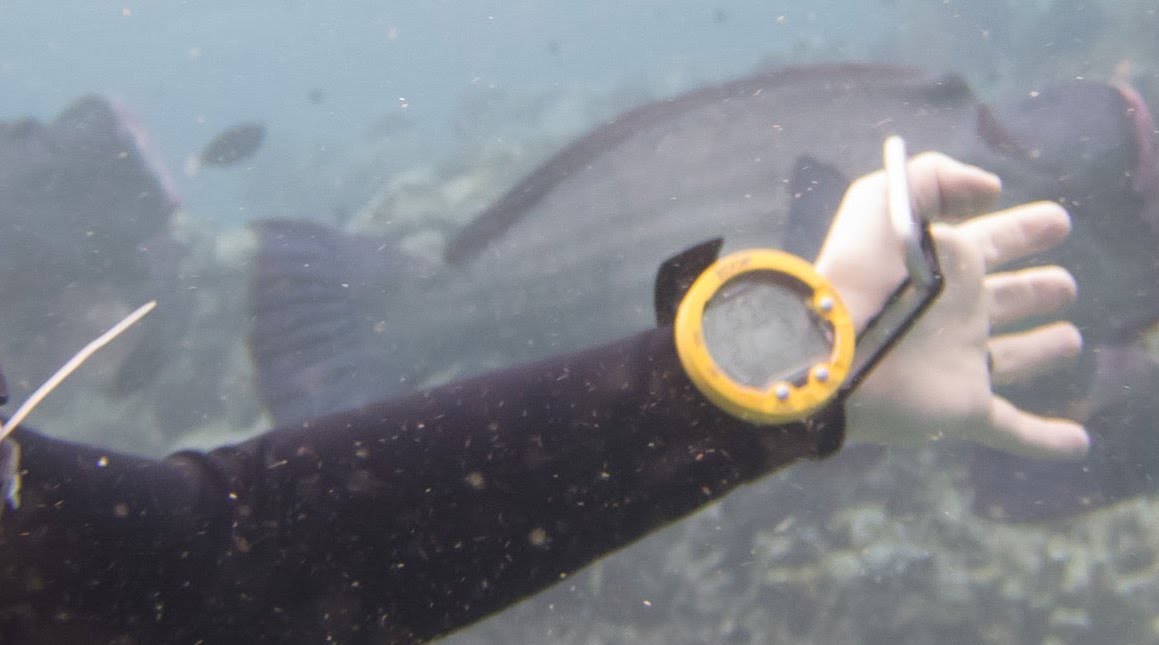
The dive computer I use as a backup is a Suunto Zoop. There are dive computers that are smaller than the Apple Watch Ultra – this is not one of them. The Zoom is now discontinued, but it is the size of an ice-hockey puck, and about as elegant. It does the trick of measuring your dive, however. These days, I keep it in a pocket as a backup. Image Credit: Haje Kamps / TechCrunch.
How do you know if you can trust a dive computer?
As mentioned, if your dive computer fails, you can still safely surface, but it would ruin the rest of your day of diving. Nobody wants to miss out on diving while on an expensive dive trip, so to know whether or not you can trust a dive computer, you need to trust a few different components of it:
- The instrumentation – A dive computer needs to keep a running log of time and depth. Most dive computers run a continuous calculation of your tissue loading, and in addition keep a log with certain intervals, so you can review your log later.
- The algorithm – Different algorithms use different levels of conservatism (i.e. how much safety buffer it has built-in, keeping in mind that everyone’s body is slightly different).
- Reliability – It is exceedingly rare that a dedicated dive computer crashes. It may run out of battery, but as a single-function device that only has to keep track of a single set of algorithms, there’s not much that can go wrong.
Evaluating the Apple Watch Ultra and the Oceanic+ app, then, becomes a question of examining the instrumentation, the algorithm and the reliability.
For instrumentation, Apple claims that the Apple Watch Ultra is EN13319-compliant; this is a European standard covering the “Functional, safety, and testing requirements” for “depth and time measuring devices.” In other words: dive computers. Apple Watch Ultra uses depth sensors that are accurate to 40 meters/130 feet. Typically, a newly certified scuba diver is licensed to 18 meters/60 feet, but most scuba diving training orgs will offer a “deep diving” specialty, which will allow divers to go to the full 40 meters/130 feet depth. Beyond that, you are looking at “technical diving,” which usually requires diving with other gas mixes. Things get complicated fast from here.
The algorithm and the user interface for Oceanic+ is offered by Huish Outdoors, which knows a thing or two about scuba diving. The company owns a number of extremely well-respected scuba diving brands, including Atomic, Bare, Stahlsac, Zeagle, Hollis, and, of course, Oceanic.
So the Oceanic brand itself is trustworthy and has been serving the dive community for 50-plus years. The other diving brands in the Huish Outdoors portfolio are extremely highly regarded and are trusted by recreational, technical and industrial/military divers all over the world. The question mark for me is that the brand doesn’t necessarily have a strong core competency as an app developer.
The truth is that Apple did choose Huish Outdoors as its launch partner to release the Oceanic+ app, giving the developer a significant head start, with the combo receiving hundreds of hours of testing, both in pressurized chambers and in real-life dive conditions. Sources within Apple suggest that other app developers will be given access to the depth sensors later this year, and it’ll be interesting to see what other brands decide to release their own versions of these apps.
The final piece is reliability. I have not experienced crashes with Apple Watch apps before, but it stands to reason that they could happen, as they could with any other app on any other platform. Incidentally, this is where Oceanic+ is, as of yet, an unknown.
Two out of the 40 or so divers that were with us on this Oceanic+ testing extravaganza experienced issues with the Oceanic+/Apple Watch Ultra combo. It’s not entirely clear if this was a user error or whether the app malfunctioned in some way. I didn’t experience any issues, and I’m not clear on whether I ought to be worried. I asked Apple about this, and they said they are unable to comment on specific incidents with beta software.
Personally, if the Oceanic+ app had failed or crashed on my dives, I’d have been a little grumpy, but as described above it doesn’t present an actual risk to divers. If you notice the app is malfunctioning, you can surface slowly and safely. Huish Outdoors did release an update of the beta app as I was writing this review, and will have its final release ready in the public App Store as you are reading this.
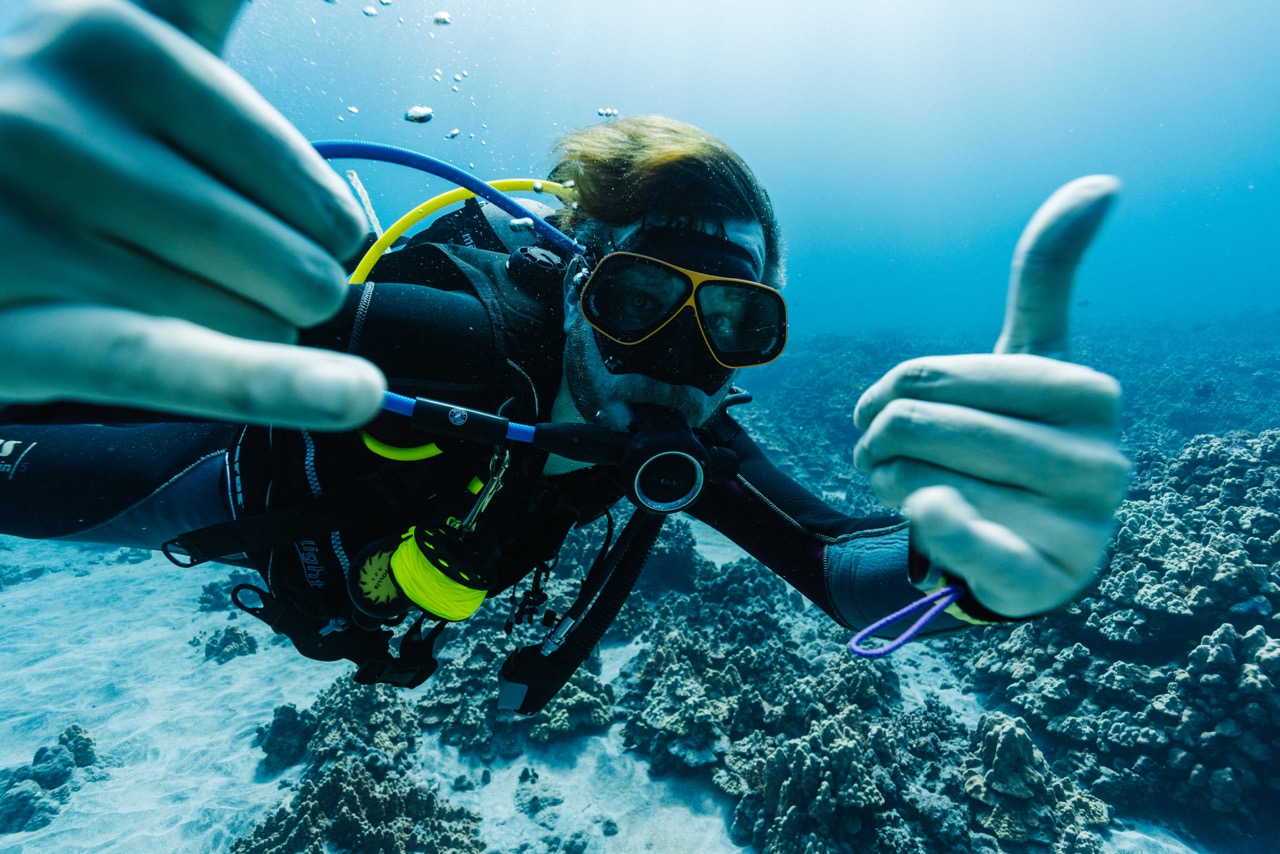
Your correspondent greeting the photographer underwater. You can see the Apple Watch Ultra on my left wrist, facing toward me, and that I am in dire need of a haircut and a shave. Image credit: Bang Bang Media.
As above, so below
Oceanic+ is a sleek, powerful Apple Watch app that essentially replicates (almost) everything a dive computer can do, and adds a few new toys to the mix. The app is in active development, and the team developing the app told me they have an extensive roadmap for fun new features it has in the pipeline. First things first, though: Getting the app into people’s hands.
The app has a number of free features which are useful for snorklers and free divers. If you want to use it as a dive computer, however, you have to pay its (remarkably well-designed) subscription fee to unlock the full functionality.
https://techcrunch.com/2022/11/28/oceanic-plus-pricing-model/
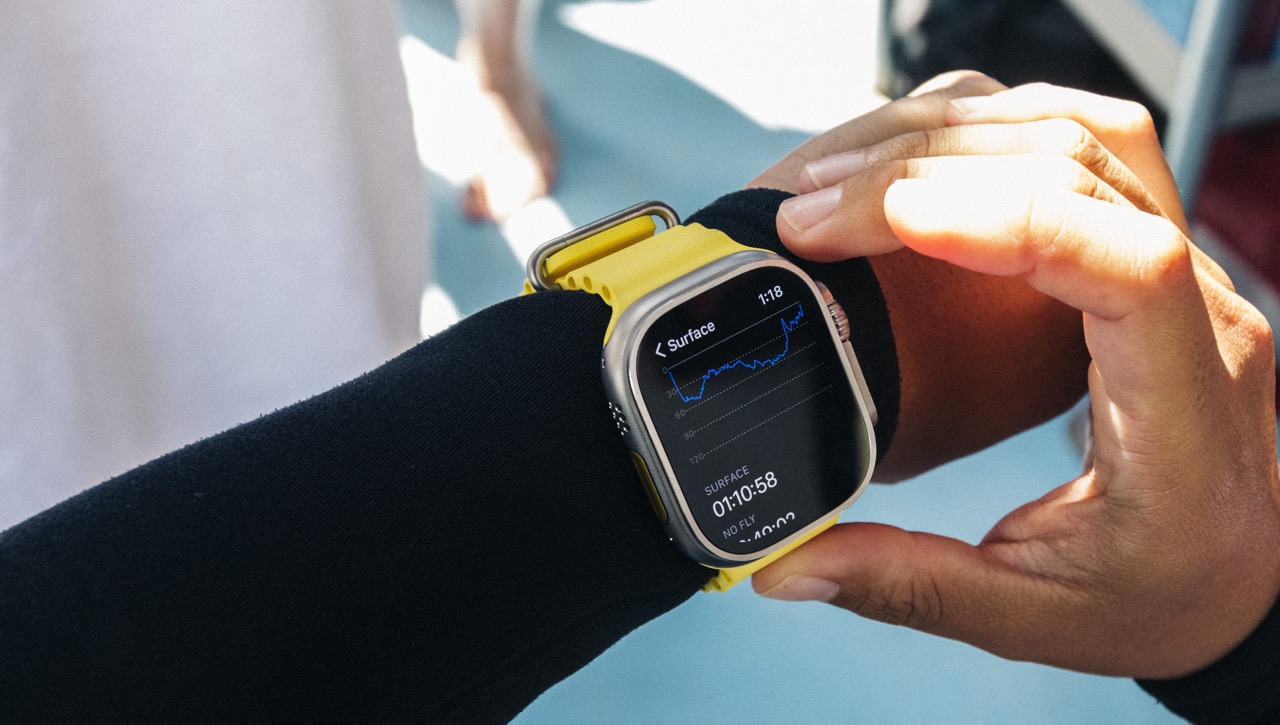
A diver inspecting their dive profile on the Apple Watch Ultra, observing it has been 1 hour and 11 minutes since their dive (known as the “surface time.”) Image credit: Bang Bang Media.
At the surface, the watch can be used for dive planning and a log book, and to configure the settings for your next dive. If you have a recent dive on the books, it can also show you your surface interval time.
None of this is rocket science; dive computers have been able to do most of these things as long as they have been around. The Apple Watch Ultra’s huge touch-screen makes the user experience significantly nicer than on traditional dive watches, which can be pretty indescipherable from time to time. Think user interfaces that seem like relics from the 1980s Casio watch era, and you get a pretty good idea.

Dive Planner, Dive Mode and the logbook are all easily accessible when you’re at the surface. Image Credit: Apple.
Dive planning helps you use your current tissue loading to figure out how deep and how long you can dive for after a surface interval.
The log book helps you see the depth profile of your recent dives, along with dive time, max ascent rate, water temperature, maximum depth and the gas mix (air at 21% oxygen or Nitrox up to 40% oxygen), sampled every 15 seconds as you are underwater. These are features you can get on any dive computer, but Oceanic+ also shows any warnings about your recent dives, and uses the GPS chip in the watch to show a map of where you dived. Small iterations, but they make a huge difference over traditional dive computers.
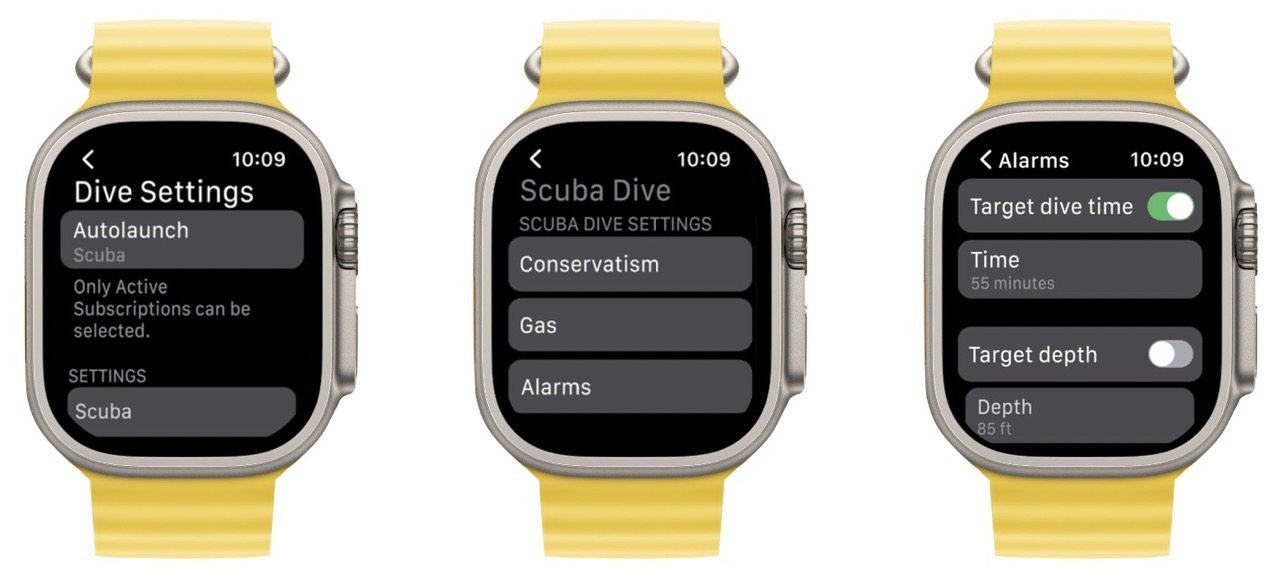
Dive settings, Scuba settings, and the dive alarm configuration screen. Image Credit: Apple.
Finally, you can configure settings for your dive, including the units you want to set your app to (Celcius or Farenheit, feet or meters, pounds or kilos) and dive mode (snorkeling or scuba), and scuba settings (partial oxygen pressure and gradient factor settings, which are safety settings usually left to advanced divers, or divers who have body compositions or medical conditions that warrant being extra careful). You can also configure your gas (air or Nitrox) and Nitrox oxygen level settings.
You can also set up dive alarms: a depth alarm to warn you when you’ve reached a certain depth and a dive duration alarm. Both are helpful to ensure you stay within your dive plan. It’s also possible to configure whether the watch automatically starts tracking dives when it senses you’ve hopped into the water or whether you need to start the dives manually.
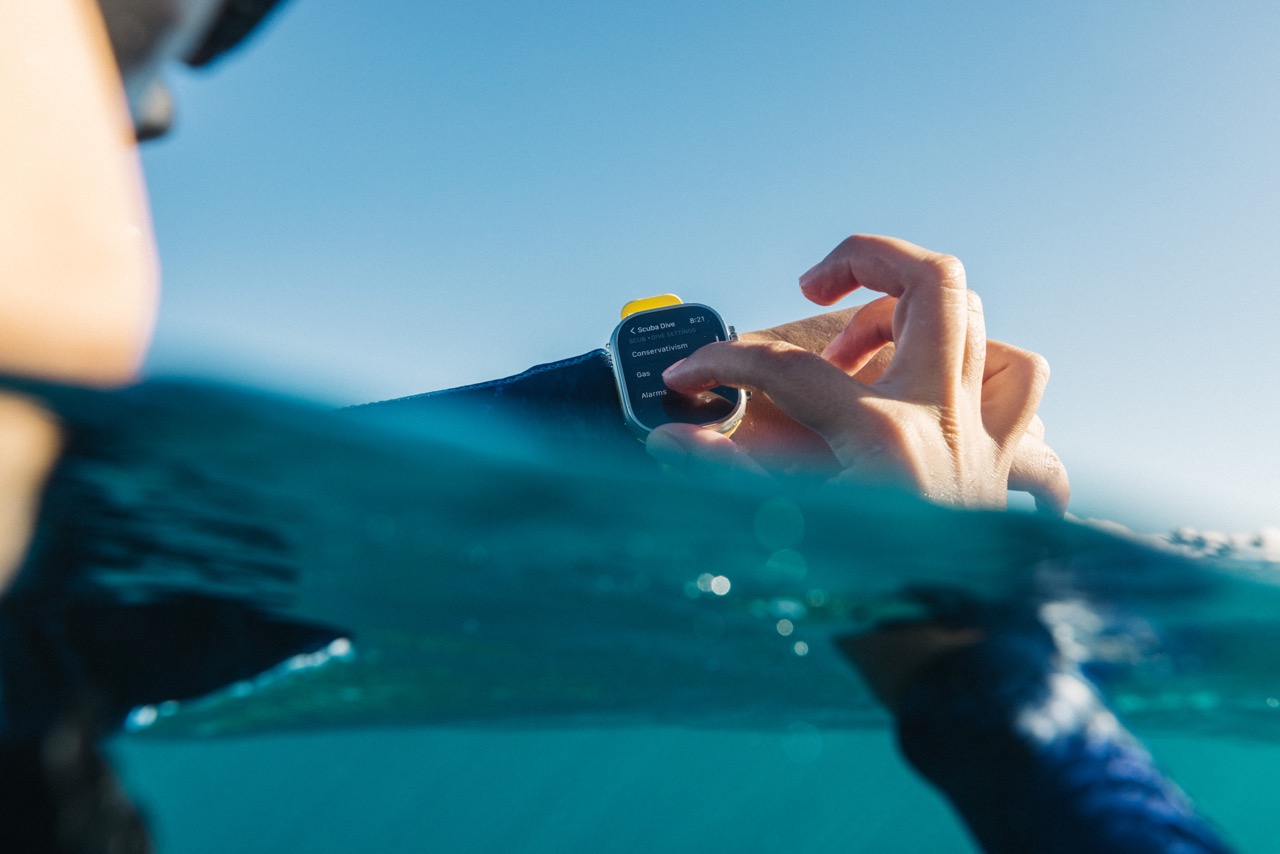
It’s possible to review the dive or adjust settings at the surface. As soon as you submerge, water lock automatically engages, and the touch screen is disabled. Image Credit: Bang Bang Media.
In the iPhone app, you can add additional notes about your dive: visibility, currents, notes about who you dived with, wildlife you saw, equipment you used, or other notes you want to take. You can also add your dive certification cards and numbers and other helpful notes.
For example, in the screen shot below, the post-dive information shows the depth profile of my dive, along with my max ascent rate (24 meters per minute). The recommended ascent rate is a maximum of 18 m/s, so the watch gave me a warning that I was being silly.
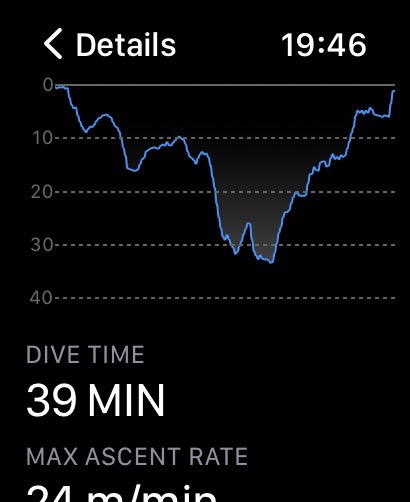
Image Credit: Screenshot from Apple Watch
Also in the app, you can plan your next dive by selecting the dive site on a map, and see recent water temperatures and other data about the dive.
Over time, the company told me it is planning to make this data crowdsourced, so divers who have been at the site recently can give you higher-resolution ideas of the temperature, visibility, currents and perhaps even wildlife spotted at various sites. Helpful if you are looking for whales or other large sea creatures!
The iPhone app still needs a little bit of work, but even with some minor graphic inconsistencies and quirks (mostly text alignment, minor typos, etc.), it gives a very good post-dive experience:
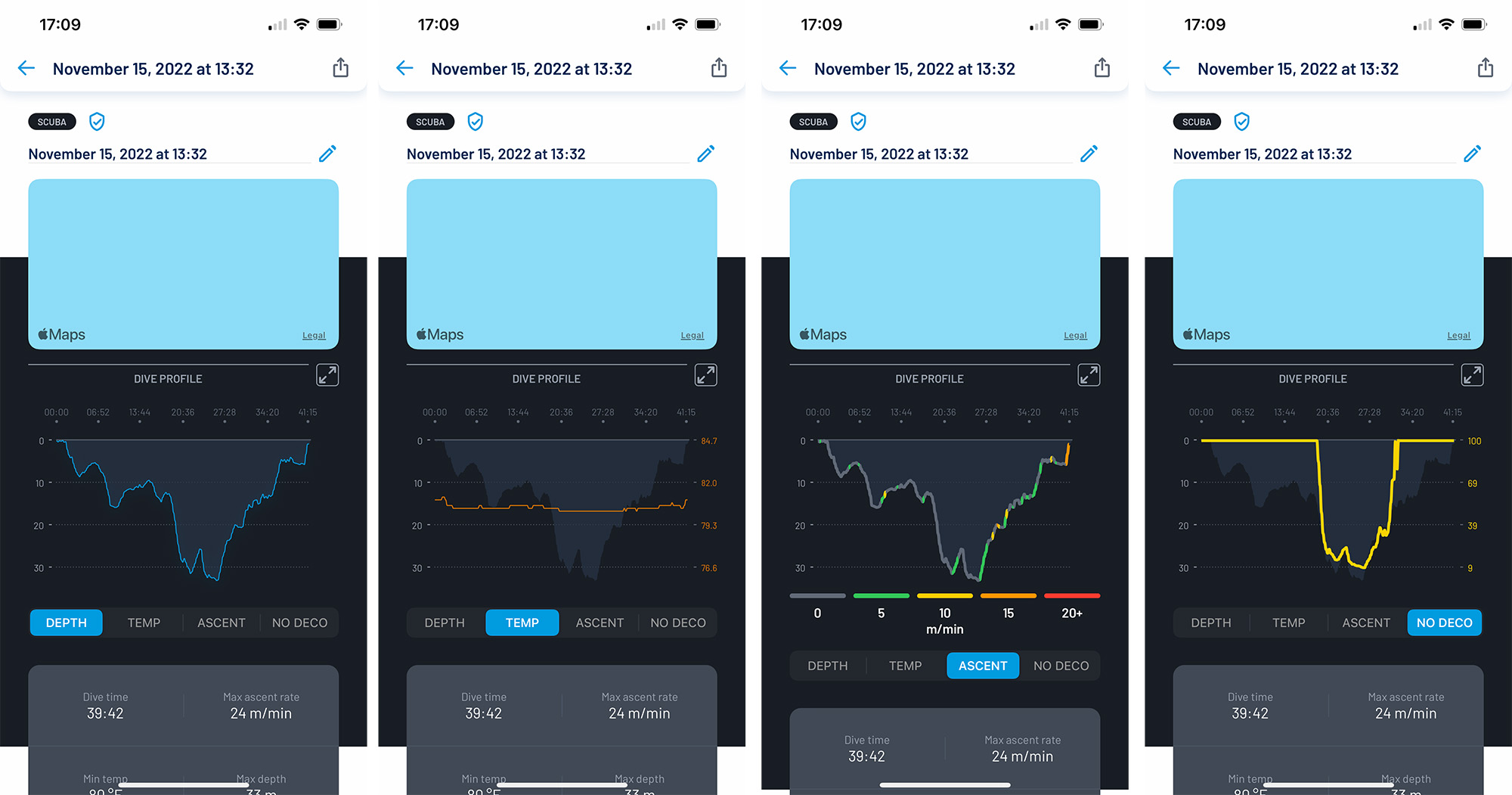
From left to right: depth chart, temperature chart, ascent rates, and remaining no-deco time. Image credit: Oceanic+ screen shots
As you can see from the screenshots, the Apple Maps preview was possibly zoomed in a little bit too far; yes, I was diving in the ocean, but without any visual cues for where I was, the map isn’t that useful.
The depth chart, temperature, ascent rates, and no-decompression (no-deco) graphs are fantastic tools for divers, however. Most dive computers let you connect to your computer with USB or Bluetooth; it was refreshing to see how seamless the Oceanic+ experience was. By the time I opened my iPhone, all my data was already synced and ready to dig into.
Taking it into the water
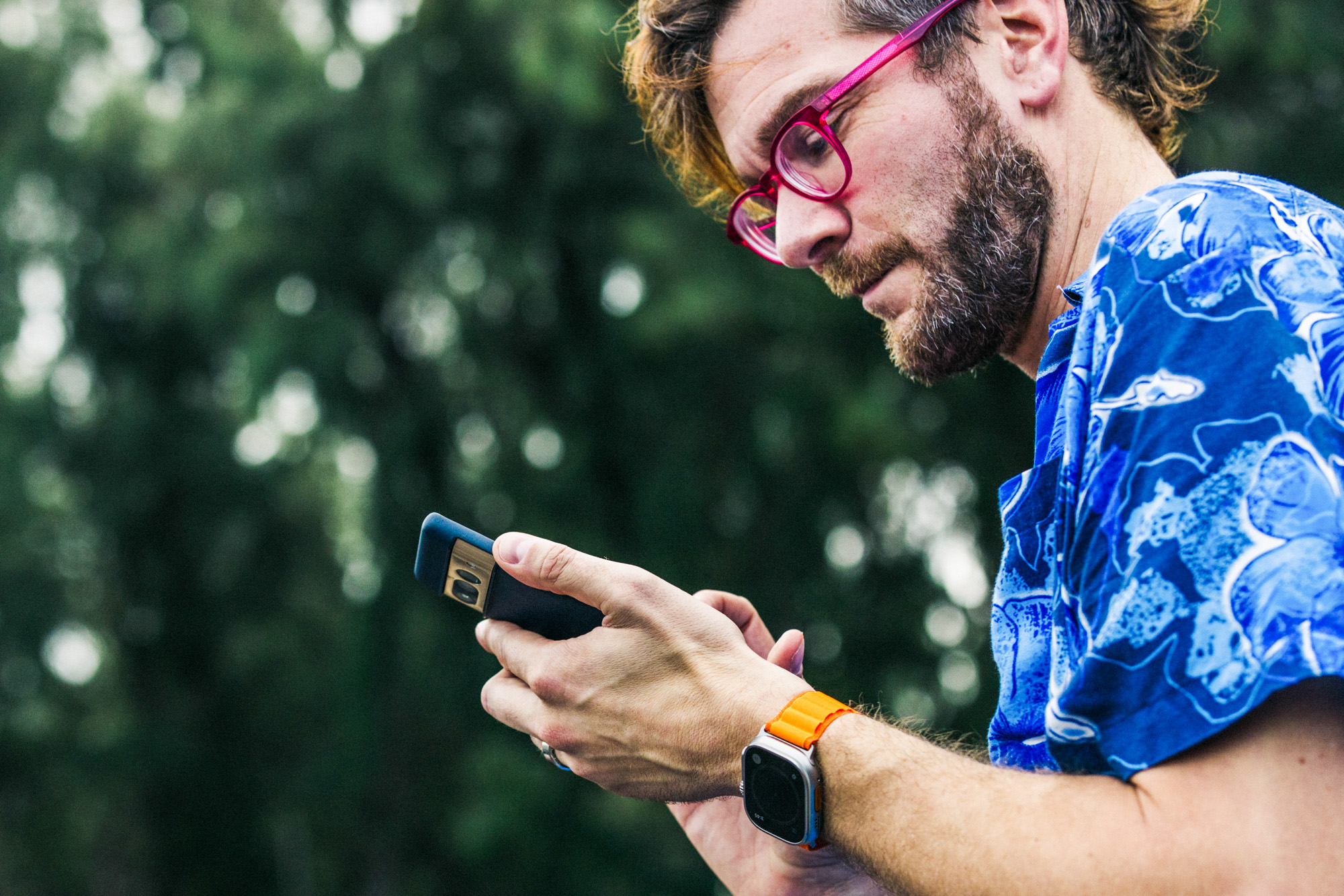
Yours truly wearing the Apple Watch Ultra. It’s very comfortable to wear with all its different wristbands, but it is a comically large watch. Let’s ignore that I’m using an Android phone in this photo, shall we. Image Credit: Bang Bang Studios
For normal use, the Apple Watch Ultra takes some getting used to. It is a very large watch, and on my puny little computer-nerd wrists, it looks comically huge. That issue goes away once I’m in the water, though; large as it is for a watch, it is about on par with an average dive computer.
In the ocean, the Apple Watch Ultra is truly in its element. The display is large, fantastically bright and very easy to read under water. Apple says it is the largest display ever on an Apple Watch, and twice as bright as the display on the Series 8.
I would be amiss if I didn’t mention the water sports band Apple has created for the Apple Watch Ultra. The ‘Ocean Band,’ as the company calls it, was designed specifically for ocean and water activities, molded from a high-performance elastomer.
The tubular geometry allows it to stretch for a perfect fit, and the titanium buckle and adjustable loop means that once it’s on, it ain’t coming off easily. The band was designed for extreme water sports, including kite surfing and other high-impact sports. Great for clumsy scuba divers like myself. I tried to rip the watch off underwater, and failed. It’s remarkably sturdy.
The company even sells a band extension if you need to wear the watch over a drysuit or a particularly chonky wetsuit.
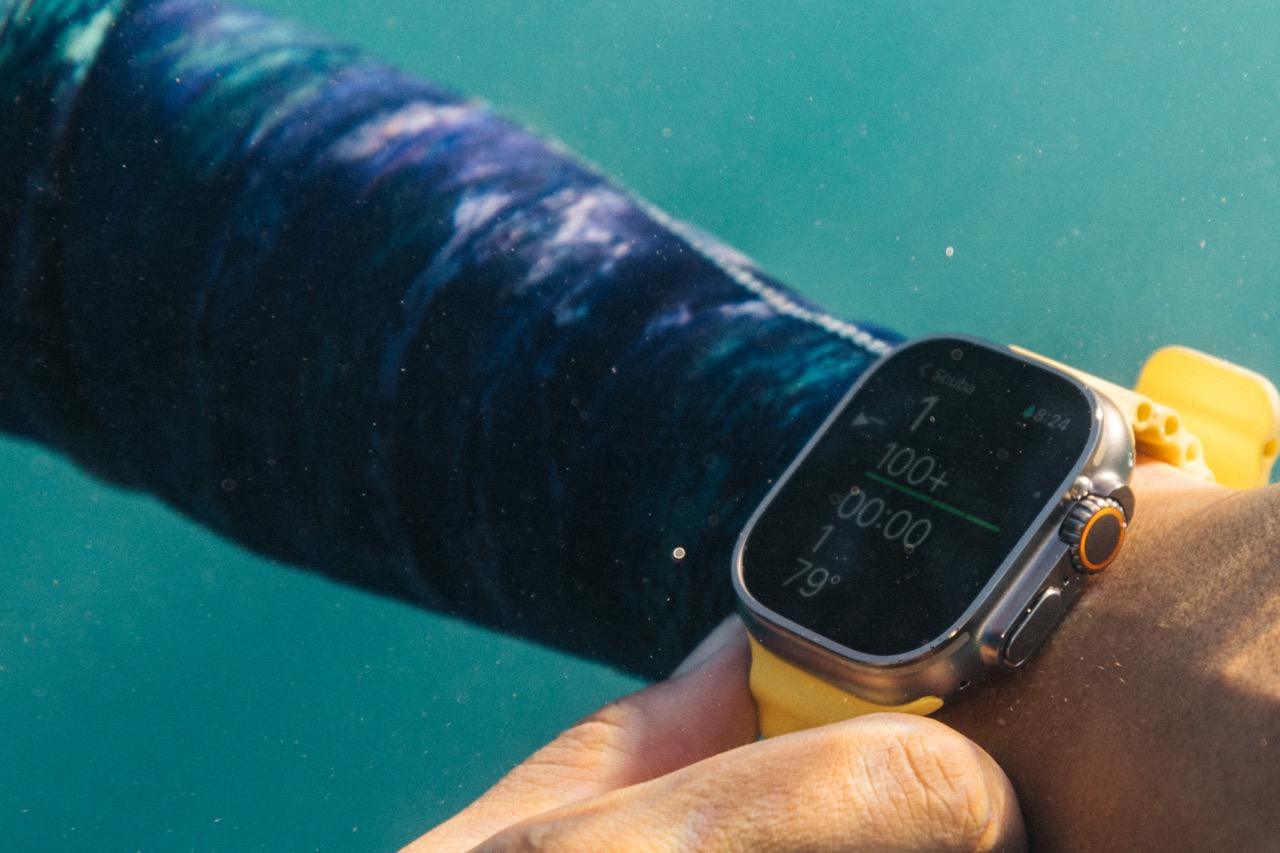
The underwater readability of the Apple Watch Ultra is extraordinary – and pretty hard to photograph, so you’ll have to take my word for it, I’m afraid. Image Credit: Bang Bang Media.
Once you activate dive mode, the watch enters water-lock mode, which means that the touch screen becomes unusable, and you have to rely on the Digital Crown (which is 30 percent bigger than Series 8 with coarser grooves) and two buttons to engage with its functions.
In addition to the crown and the side button, both of which are slightly raised so they can be easily used even when you are wearing gloves, the Apple Watch Ultra has an orange Action button. When diving, this can be used to dismiss warnings and alarms, and to select a compass heading on the underwater compass.
The crown is protected by a titanium guard to help prevent accidental rotations, and the sapphire glass on the watch is protected by a titanium bezel all the way around. All great features to have on a dive computer.
The watch uses water-based sensors only during a dive: depth gauge, water temperature, and the compass, in addition to the time. You don’t get the vital readings (heart rate, etc.) that you would get on a run, which I think makes a lot of sense. Apple suggests that measuring vitals is hard to do consistently underwater, and in any case I ended up wearing the Apple Watch Ultra over a wetsuit anyway, so it couldn’t have made a reading if it had wanted to.
In use in the deep blue sea
Once a dive is started and the water lock mode is on, you can use the Digital Crown to scroll through a number of information screens. On all screens, you can see your current depth and no-deco time. Always on screen is also a variometer, which moves up and down as you ascend or descend. It can be remarkably hard to determine whether you are moving up and down in open water, so that’s a very helpful tool to keep you level in the water, for example when doing a safety stop.

Primary screen, Secondary screen, Compass screen, and the Air screen. Image Credit: Apple.
You can rotate the Digital Crown to access additional screens or press the Action button to set a compass heading. On the various screens, divers get access to a bunch of extra information.
Primary screen:
- Dive Time – helpful to know how long you’ve been under, and when the boat expects you back
- Minutes to Surface – how long would it take to safely ascend to the surface, including a safety stop
- Water Temperature – never really all that helpful, as there is not much you can do about it once you’re in the water and realized you didn’t wear a warm enough wet suit
Secondary screen:
- Max depth for this dive – helpful to ensure you are sticking to the outlined dive plan for this dive
- Current ascent rate – good to keep an eye on when you are surfacing from your dive to ensure you are ascending at a reasonable rate
- Percentage battery left in the Apple Watch Ultra – the battery life on this thing is extraordinary, but it’s good to be able to check
Compass screen:
This is a super helpful screen; underwater compasses are crucial, and often one of the only ways to know which way you are facing underwater. Traditional compasses are a royal pain in the wetsuit to use, and the Oceanic+ app has one of the best implementations I’ve ever seen.
- Current compass bearing
- Target compass heading (set using the Action button)
Air screen:
This screen confused me a little; I doubt it’d come in all that helpful most of the time, but it’s neat to be able to verify that your watch is using the settings you thought it was.
- Conservatism
- Gas settings – air vs Nitrox, and oxygen percentage if you’re diving on Nitrox
- Max oxygen partial pressure setting. This is good to know, as oxygen can become toxic to the central nervous system at high partial pressures. Here’s a “fun” fact for you: Oxygen can be toxic to humans if you breathe pure 100% oxygen at as little as 6 meters/20 feet deep.
In addition, the watch will use a powerful haptic signal, easily felt through a wetsuit, to draw your attention to it when it needs to tell you something.
It can give safety warnings such as decompression limits, excessive ascent rates and safety stops. It can also warn you if you’re at your maximum operating depth (which varies based on what gas you are breathing), and buzz you with any depth or time alarms you have set.
The alarms are very well color coded: Red for things that need immediate action, yellow for warnings, and blue if the water temperature drops below your configured threshold. And the large, bright screen and prominent haptics means you’re not going to miss anything.
Below are some examples of the warning screens: too-rapid ascent warning; safety stop reminder; target depth alarm; and temperature alarm. The green lines across the middle of the screen is the tissue loading. If it goes all the way down, you are out of no-deco time, and it’s time to surface to avoid unnecessary risk of decompression sickness.
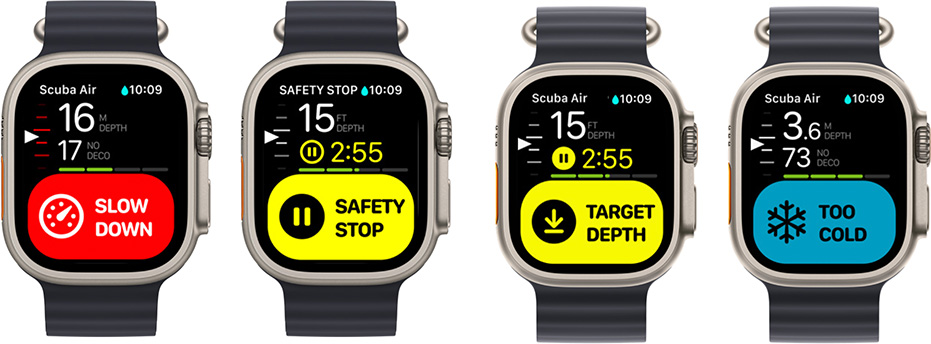
Image Credit: Apple.
Once in the water, there is remarkably little to say about the Apple Watch Ultra as a dive computer: It’s easy to use; the crown and buttons are phenomenal as far as user interfaces go, the screens are well-designed; and the important information is clear and very easy to read.
I brought my trusty old Suunto that has been with me on many a dive to serve as my secondary dive computer for these test dives. The readouts from the two dive computers were almost identical all the way through. The small differences can be attributed to having the Suunto in my pocket while the Apple Watch was on my wrist.
The Suunto also uses a slightly different algorithm. Having said that, trying to compare the dive profiles on the two devices reminded me why the Oceanic+ was such a great leap forward. Even figuring out how to step through a logged dive on the Suunto is an unmitigated, miserable disaster. We’ve come a long way in dive tech.
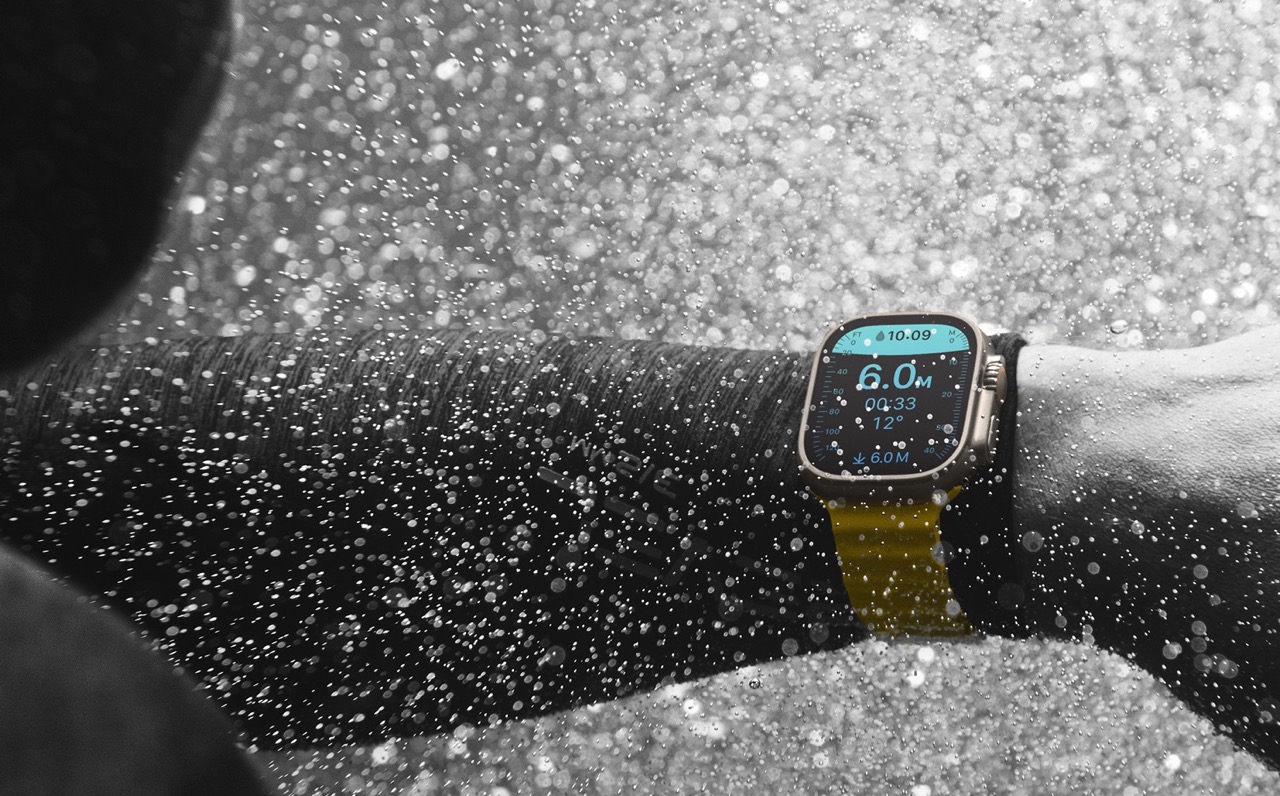
Easy to read underwater. Image Credit: Apple
What is missing?
Apple Watch Ultra plus Oceanic+ is a hell of a combo. It’s heads and shoulders above the competition in terms of screen and user interface, and the automatic syncing and logging to my phone is a fantastic perk. Which isn’t to say that the Apple Watch does quite everything yet.
Most high-end dive computers are “air integrated,” meaning that a transmitter can be added to your first-stage regulator, which transmits how much air you have left in your tank to your dive computer. Rumor has it that Oceanic+ and Apple Watch Ultra might have something in the works to add air integration at some point in the future, although both companies remained tight-lipped on if and when when this might be available.
As you climb closer to the $1,000 mark, dive computers are also able to do more exotic gas mixes, mostly used for technical diving. They are also better at doing decompression diving, which is dives where you exceed your no-deco time, and need to stay underwater for longer to off-gas.
I suspect the Oceanic+ app has deco algorithms in place to save your bacon in case divers accidentally overstay your no-deco time, but I wasn’t able to verify this before this article was published. Again, not something you would expect recreational divers to run into on the regular. For context, in my hundreds of dives, I have only ever once had to do a decompression dive; it involved staying at 10 meters for 6-7 minutes extra.
One advantage the Apple Watch Ultra has over traditional dive computers, however, is that most dive computers spend 11 months of the year in a drawer, whereas Apple’s device can be used for, well, the hundreds of things that people use Apple Watches for, including making calls, fall detection, health tracking, notifications and much more. On a cost-per-day-used basis, the Apple Watch Ultra is an absolute bargain compared to every dive computer on the market today.
I can’t help but wonder if we have entered a similar space for dive computers that we saw for sat-nav devices some 15 years ago. If you’ll recall, in the time before iPhones, there was a period where everyone had dedicated sat-nav devices from manufacturers like TomTom and Garmin. When the iPhone came along, they delayed their own demise in this space by releasing mapping apps for the new phone platform with significant price tags, before they were all destroyed by the likes of Google Maps, Apple Maps, Waze and other free mapping apps with live traffic data.
It wouldn’t surprise me if at some point in the non-too-distant future, as prices of Apple Watch Ultra and similar devices come down, dive computers will seem as anachronistic as using a suction-cup to put a Garmin device on your windshield does today.
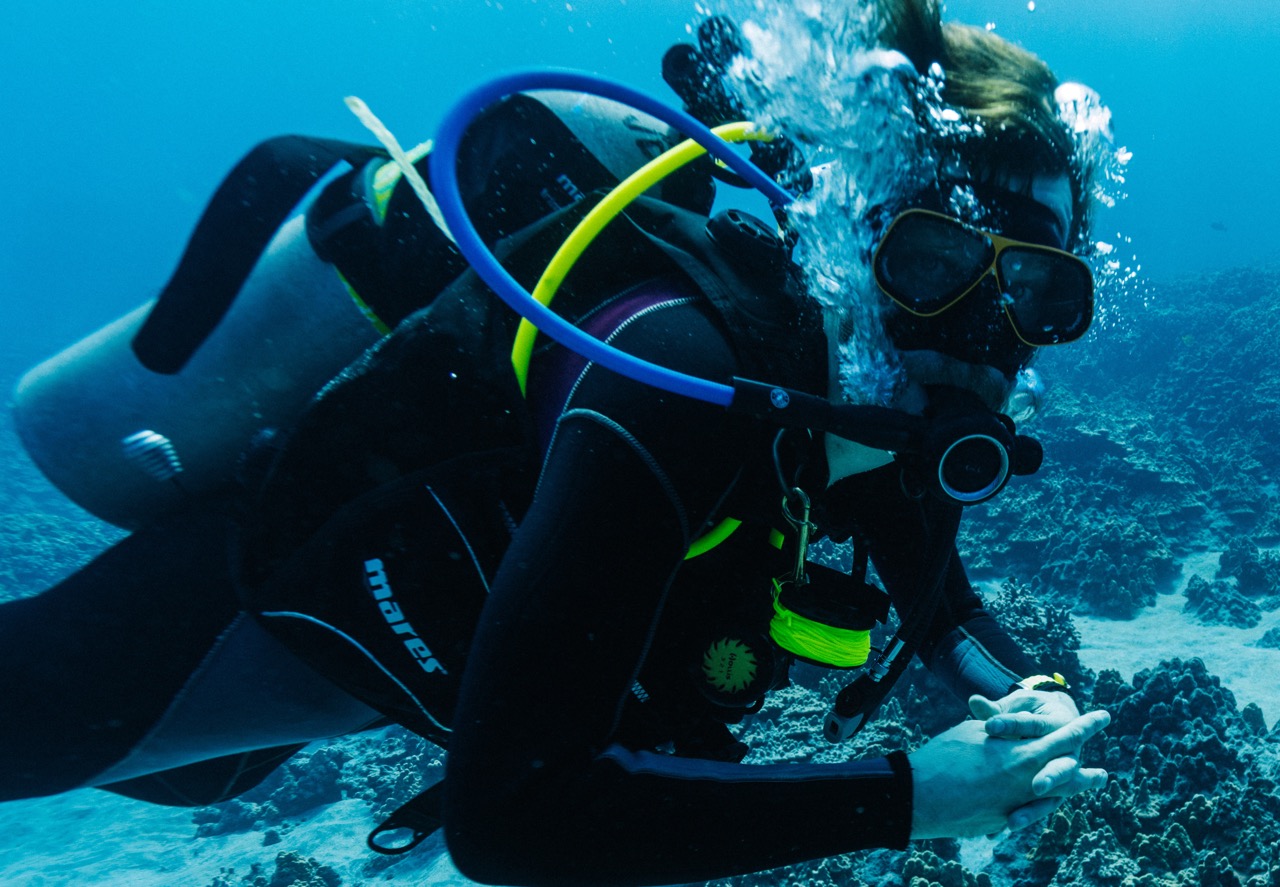
Sup. Image Credit: Bang Bang Media.
Should you take the plunge?
Time will tell if an $800 watch is accessible enough to put a major dent in dive computer sales. After all, $500 buys you a great entry-level dive computer. It is admittedly far larger than the Apple Watch Ultra, and not nearly as nice or as easy to use as the Apple/Oceanic+ combo. A higher-end dive computer, however, like Suunto’s D5 or Oceanic’s own ProPlus 4 computer, cost about the same as the Apple Watch Ultra.
Would I recommend that you trust your dive holiday to an Apple Watch and an Oceanic+ app? Yes, with a caveat. I would need a few more dives with a backup dive computer in my BCD pocket before I would rely on the Oceanic+ app by itself.
I’d trust it as long as Huish Outdoors ensures that the stability and reliability of the app remain its No. 1 priority over all the fun bells and whistles it could be tempted to add over the next months and years. And if the app continues to stay stable, I can’t imagine it will take very long before the skeptic in me fully embraces it.
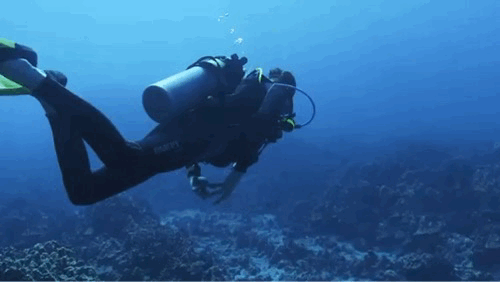
 Thanks for reading, see you on the reef! Video credit: Bang Bang Media
Thanks for reading, see you on the reef! Video credit: Bang Bang Media
We went diving with the Apple Watch Ultra by Haje Jan Kamps originally published on TechCrunch
https://techcrunch.com/2022/11/28/oceanic-plus-apple-watch-ultra-scuba-diving/

